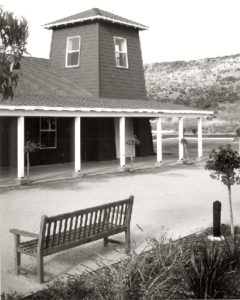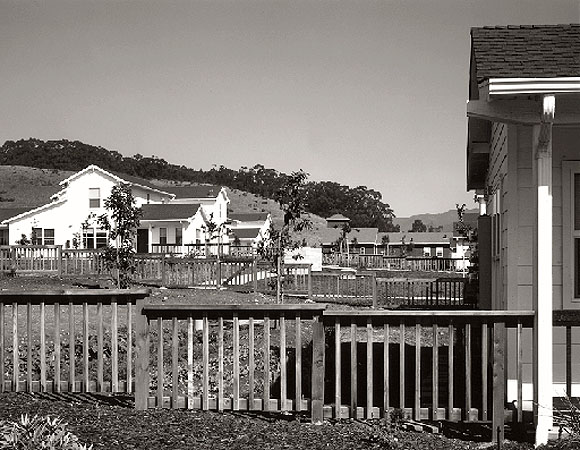Moonridge Village
Half Moon Bay
David Baker FAIA & Associates, San Francisco
Merit Award for Affordable Housing
Photos by Cesar Rubio
Mention “Silicon Valley,” and the last thing people think of is impoverished farm workers. Just over the hills from Woodside, however, along the coast of wealthy San Mateo County, farm workers’ families live in broken down trailers and makeshift shacks, or squeezed twelve together into two-bed- room apartments.
In 1983, in response to these dismal housing conditions, County Supervisor (now Congresswoman) Anna Eshoo proposed development of a 40 acre valley just east of Highway 1 below Half Moon Bay. Sixteen years later, after innumerable challenges, Moonridge Village opened in September 1999, providing homes for 80 families out of thousands who had applied by lottery. In 2001, 80 more units will complete the plan.
From the outset, the project faced difficult hurdles: lack of water and available sewer capacity and a lawsuit by the local school district, in addition to the typical scarcity of funds. After extended negotiations, a water supply was secured through an agreement between the county and the water district to bring a pipeline seven miles over the mountains from Crystal Springs.

Through all the challenges, the developer, Mid- Peninsula Housing Coalition, remained steadfast and, working with David Baker FAIA & Associates, brought a successful project to fruition. Baker combines four unit types in numerous duplex and fourplex configurations to squeeze considerable variety out of what is necessarily a repetitive scheme. Each unit has its own front porch and back yard, and the complex is formed around a series of community gardens, citrus groves, and tot lots. Community facilities, including laundry, day-care, computer lab, post office, and community room and kitchen, surround a central zocalo, or plaza, five-minute’s walk from the furthest dwelling. A soccer field, basketball court and inline skating court anchor the end of the development nearest Highway 1.
Mid-Peninsula Housing does not just build and manage buildings. With the help of Cabrillo Adult Education and the College of San Mateo, they are offering on-site English and computer courses. Sor Juana Inez, a counseling service for Latina women, has on-site programs, as does the Corporation for Therapeutic Convivials, which brings the village men together around the community gardens. Programs for children include Coast Side Head Start, which is headquartered at Moonridge, and a Summer Enrichment Program.
Moonridge Village has won not only an AIACC Merit Award, but also a Tax Credit Excellence Award from the Affordable Housing Tax Credit Coalition. Fran Wagstaff, Executive Director of MPHC, says that these awards lend credibility to their effort to demonstrate comparability with market rate quality—to produce housing that is not (as is too often considered appropriate) merely “good enough for those people.” What is she proudest of? “It’s wonderful for children.”







